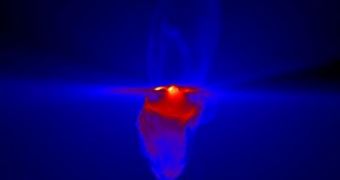For more than two decades, astrophysicists have been puzzled by a very strange cosmic event. Every time a new, massive star is born – of the class whose members have several hundred times the mass of our Sun – it continues to gather material from the remnants of the clouds that collapsed to form it. This shouldn't happen, physicists said, because their density is large enough to fuse hydrogen nuclei together – causing nuclear fusion – which produces massive amount of brilliant radiation. These emissions should blow the nebulae away from around the star, but for some mysterious reason they don't.
Now, a new scientific research, based on computer simulations, finally answers the riddle. In charge of the investigation was an international group of experts, featuring scientists from the University of Heidelberg, the American Museum of Natural History, the National Autonomous University of Mexico, and the Harvard-Smithsonian Center for Astrophysics (CfA). The models have revealed that the reason why nebulae are not pushed away is the fact that they tend to form very dense filamentary structures, which are capable of absorbing the powerful radiations that the baby stars give off.
In essence, what this means is that the force of the blow is diminished sufficiently enough in order to allow for the nebulae to endure around these large fireballs. “To form a massive star, you need massive amounts of gas. Gravity draws that gas into filaments that feed the hungry baby stars,” says AMNH Department of Astrophysics curator Mordecai-Mark Mac Low. The expert is also a coauthor of a new study detailing the findings, which appears in the latest issue of The Astrophysical Journal. What happens when the radiations hit these filamentary structures is that they make the whole nebula flicker like a candle, but without extinguishing it.
“So far, these ionized nebulae were just thought to be expanding bubbles of hot gas, and the measured size of these bubbles was used by observers to infer the age of its central star. Our results are of particular importance because the simulations show that there is, in fact, no direct relation between the size of the nebula and the age of the massive star, so long as the star is still growing. This is the case over a significant fraction of the total lifetime of a massive star,” says University of Heidelberg Center of Astronomy researchers and former Annette Kade Fellow at the Museum, Thomas Peters. He was also the first author of the journal entry.

 14 DAY TRIAL //
14 DAY TRIAL //